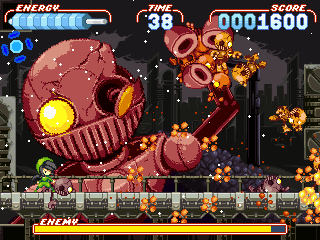
Joakim Sandberg has just released Noitu Love 2: Devolution and I highly recommend you check it out. You can pick up the demo for free, but it’s worth the $20 for the full version. It’s the answer to a single burning question: what would happen if you made a platformer that properly incorporated both mouse and keyboard? It gives three perfect answers. Click through for the discussion and minor spoilers.
Noitu Love 2 is the sequel to Noitu Love & the Army of Grinning Darns, which is a quite competent beat-em-up platforming game. NL2, however, incorporates the mouse, and becomes something much nicer. The main character, Xoda Rap, has the capability of dashing to any enemy the player clicks on, and repeated clicks attack repeatedly, keeping Xoda floating in midair as she destroys enemy after respawning enemy. This gives an amazing feeling of mobility and speed. The action is frantic and fast-paced, and would be great if it just ended after the uncomfortably difficult final boss. It took me about 90 minutes to reach that point. I’d put the expected time of that mode at one to three hours.
It doesn’t end there, though. Completing the game with Xoda unlocks a new player character: Rilo Doppelori, the sometimes-antagonist of the Xoda story. Rilo gets minor changes to the existing levels (she fights Xoda where Xoda fought Rilo, and she gets a different end boss earlier in the game), but what’s great is that she has an entirely different mouse-based control system.
Rilo uses a rocket launcher, and this is a typical click-to-shoot affair, like several shooting platformers I’ve played. She has a secondary ability, though, that’s reminiscent of Sandberg’s earlier Chalk and the boomerang mechanic in the later Zelda games. You lock on to multiple enemies while holding the right mouse button, and then release it to fire a beam at them that’s stronger the more enemies are targeted. It’s interesting playing through the same game with this different scheme, and the new end boss incorporates it well.
But that’s still not all. After beating the game as Rilo, you get a third player character: Almond, the lovable, vulnerable abductee that serves as Xoda’s intercom boy. And Almond gets a third control scheme. The player fires at enemies and reloads with a scheme that feels like a light-gun game, while Almond mostly huddles under a shield and scoots around on his stomach. The most amusing part is that Almond is a terrible jumper; in order to navigate the levels, the player must actually pick him up with the right mouse button and drag him around the screen, like a patron in the Roller Coaster Tycoon games. The same levels, the same enemies, but a totally different feel.
I’m still in the process of playing through as Almond, but this game already impresses me on its versatility. It’s like a set of variations on a theme; it’s like Sandberg asked himself, “How else could I have designed this?” and ran with it. I’d love to see this done more. The later Castlevania games, with their alternate PCs, come to mind, but those games are so very long that playing through again feels like a chore. With this short yet sublime game, however, it’s fun and fresh and quite interesting.